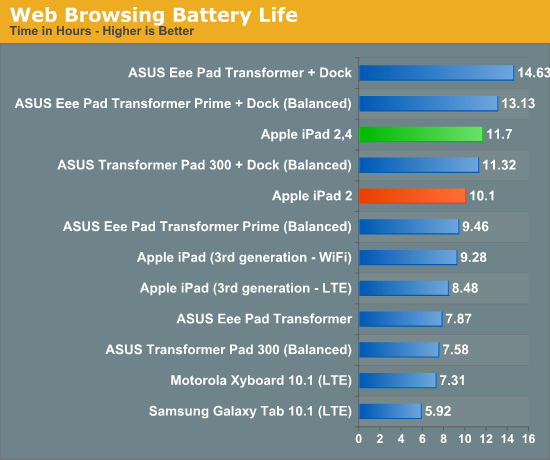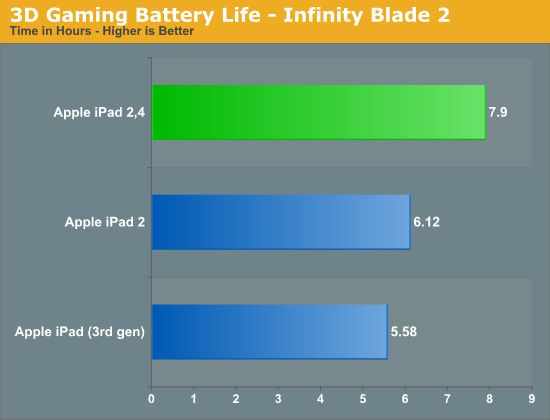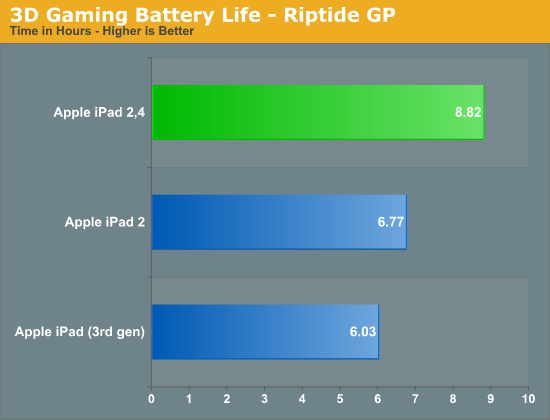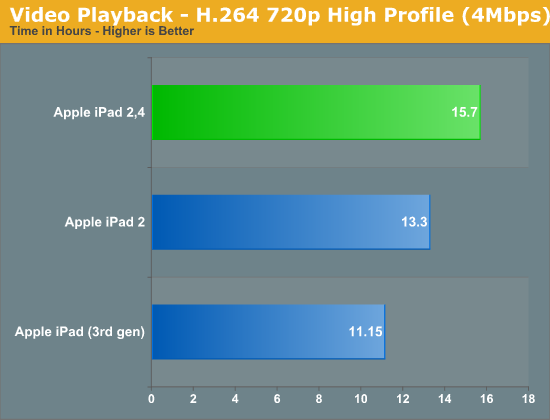The iPad 2,4 Review: 32nm Brings Better Battery Life
by Anand Lal Shimpi on May 4, 2012 12:50 AM ESTSignificant Battery Life Improvements
We'll start with the latest iteration of our WiFi web browsing test. With some additional logic to defeat overly aggressive browser caching, this test cycles through dozens of web pages, pausing on each one to simulate reading time before moving onto the next one. Display brightness is kept constant at 200 nits while the test runs. Results are reported in hours of battery life before the tablet dies.

Most web browsing tests end up being significantly display limited, as in the display dominates most of the power draw. That being the case, the fact that we see a 15.8% increase in battery life from the new 32nm HK+MG SoC alone is very significant. Apple is very conservative internally about revising battery life ratings so it's no surprise that we don't see a change in the specs on the iPad 2, especially considering that so many units out there on the market are still older iPad 2,1 models.
The increase in battery life here is almost certainly due to lower leakage at idle and better active power as well. This is a real improvement.
Things get even better when we stress the real power hog on the SoC: Imagination Technologies' PowerVR SGX 543MP2 GPU. Taking up more area on the die than the dual Cortex A9 cores, the 543MP2 is really stressed during 3D gaming. What better way to measure the impact of the new 32nm SoC on battery life than with one of the most stressful 3D games out for iOS today: Infinity Blade 2.
Here we're looping through the same scene until the battery dies, once again at normalized brightness.

The 3rd generation iPad obviously doesn't do as well as the iPad 2 here, as it not only has a more power hungry GPU but it's also rendering the scene at a higher resolution (and driving a higher resolution panel). What's most impressive however is just how much better the iPad 2,4 does here: a 29% increase in battery life over the original iPad 2,1.
Riptide GP, a less stressful title, shows us similar results:

Finally we have our brand new video playback test. Here we've got a copy of the last Harry Potter movie with the credits stripped out (1:58:00 running time), transcoded to a 720p High Profile H.264 video with a 4Mbps average bit rate, playing back in a loop until the battery dies.

The iPad 2 holds a 19% advantage over the 3rd generation iPad (once again for obvious reasons), however the iPad 2,4 absolutely dominates with an 18% increase in battery life. At 15.7 hours this is an insane amount of battery life from a single charge. Granted end users will see lower numbers if you watch at higher brightness settings (200 nits on our test panel was around 40% brightness), but the advantage from the new iPad should still remain just as significant.










100 Comments
View All Comments
spdfreak - Monday, May 7, 2012 - link
Display model at the BB here in Douglasville, GA was running 5.1 so I guess it is the newer model?BlazeEVGA - Friday, May 4, 2012 - link
"It's also only available in a single capacity." Please clarify...
MorphiusFaydal - Monday, May 7, 2012 - link
The iPad 2 (post new iPad release) is only available as a 16 GB WiFi-only model. So it's only available in a single capacity.shompa - Friday, May 4, 2012 - link
Why do all believe that smaller process nodes decreases the cost of manufacture the chips? Yes: You can fit more die candidates on a smaller process node, but the wafer price is raised for each new processor node.Only of you own you own fabs and don't count the migration cost from one node to another node you are guaranteed a cheaper price per node shrink.
shompa - Friday, May 4, 2012 - link
Apple must have hired hundreds/maybe thousand of people working on their SoCs. PA Semi + more.To make a new tapeout/masks for exactly the same processor that is used today. I can't recall that in history.
If we believe the rumors that Apple got test wafers from TSMC june and october last year, then Apple designed at least 3 SoCs last year.
A5X, A532nm and A6/ARM15.
PeteH - Friday, May 4, 2012 - link
Wouldn't Samsung be responsible for the masks?name99 - Friday, May 4, 2012 - link
"This is nothing new, but it's always interesting to get an idea of the amount of variance Apple considers acceptable."I think it's important to distinguish between variance that Apple considers acceptable (because it doesn't really make a difference) and variance Apple considers acceptable (because what choice do they have?)
I have complained to Apple about how irritating it is to have items that should be consistent (think of contact photos shared via iCloud for example, where the human eye is very sensitive to minute variations) appear different on iMac, iPad, MBA, and iPhone screens; and I suspect Apple is sympathetic to the problem. But screen technology is where it is today, and right now we have to accept these sorts of variations as part of the deal (different companies, different processes, lots of experimentation) that gives us really amazing quality screens for just a few hundred dollars each. Maybe in ten years we'll be in a position to deliver a single consistent screen appearance across the entire product line.
(And as for people who think complaining that contact photos look different on different screens is the height of pettiness: perhaps there's a reason that the one company that appears to care about these minor details is ALSO the one company that's making money hand over fist in this area?)
Reflex - Friday, May 4, 2012 - link
Was this a comparison of a brand new iPad 2,1 to a brand new 2,4? I ask because the 15% gain seems dubious when the CPU is such a tiny portion of the overall power budget. What I do know is that over time LiON batteries lose their charge capacity, so comparing a year old iPad2 to a brand new iPad2 would show the new one as having better battery life even if they had identical internal hardware.Did I miss this in the review?
Anand Lal Shimpi - Friday, May 4, 2012 - link
I got this question via email as well:All of the tests were re-run on a newer but not brand new iPad 2, with very few charge cycles (< 20) on the battery. I also ran a test comparing battery life of the older iPad 2 at new vs. when tested and showed no measurable decrease in battery life (you can actually see that video playback battery life hasn't changed even compared to our original iPad 2 review). Finally, the power consumption results remove the battery from the equation and validate the difference in power.
The web browsing test is going be primarily dominated by display, followed by SoC power consumption. Keep in mind that even when the CPU cores aren't busy parsing HTML and running javascript, leakage is still a problem - Samsung is promising a ~10x decrease in leakage from the move to 32nm.
Take care,
Anand
Reflex - Friday, May 4, 2012 - link
Thanks for the reply, its appreciated.